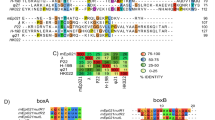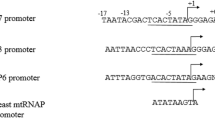Summary
Bacteriophage T4 gene 32 lies at the 3′ end of a complex transcription unit which includes genes 33, 59, and several open reading frames. In the course of an infection, four major transcripts are synthesized from this unit: two overlapping polycistronic transcripts about 3800 and 2800 nucleotides in length, and two monocistronic gene 32 transcripts about 1150 and 1100 nucleotides in length. These transcripts are made at different times in infection and the polycistronic transcripts have segmental differences in stability. Messenger RNA processing yields a 1025 nucleotide monocistronic gene 32 transcript, and a 135 nucleotide transcript containing part of the gene 59 coding sequence. Processing depends on Escherichia coli encoded ribonuclease E. This pattern of transcription and processing leads to the synthesis of gene 32 mRNA throughout infection, whereas transcripts encoding the upstream genes are present only early in infection. The 3800 nucleotide polycistronic transcript initiates at a promoter that does not require T4 encoded factors for activity. However, full-length synthesis of this transcript depends on the T4 mot gene product. The region upstream of gene 32 also contains four E. coli-like promoters that are active on chimeric plasmids in uninfected cells, but inactive in bacteriophage T4. The location of these cryptic T4 promoters is intriguing in that they lie near the 5′ ends of open reading frame B, gene 59 and gene 32. They could play a role in phage development under particular conditions of growth or in bacterial hosts other than those examined here.
Similar content being viewed by others
Abbreviations
- am :
-
amber mutation
- gal :
-
galacto operon
- gp:
-
gene product
- lac :
-
lactose operon
- su :
-
suppressor
- t:
-
transcription terminator
- ts :
-
temperature sensitive
References
Alberts BM, Frey LM (1970) T4 bacteriophage gene 32: a structural protein in the replication and recombination of DNA. Nature 227:1313–1318
Alberts BM, Morris CF, Mace D, Sinha N, Bittner M, Moran L (1975) Reconstruction of the bacteriophage T4 replication apparatus from purified components. In: Goulian M, Fox CF (eds) DNA synthesis and its regulation. WA Benjamin Inc, Menlo Park, CA, pp 241–269
Albright LM, Geiduschek EP (1986) Topoisomerization of plasmid DNA in Escherichia coli infected with bacteriophage T4. J Mol Biol 190:329–341
Belin D, Mudd EA, Prentki P, Yu Y-Y, Krisch HM (1987) Sense and antisense transcription of bacteriophage T4 gene 32. J Mol Biol 194:231–243
Bolle A, Epstein RH, Salser W, Geiduschek EP (1968) Transcription during bacteriophage T4 development: synthesis and relative stability of early and late transcripts. J Mol Biol 33:325–348
Borowiec JA, Gralla JD (1987) All three elements of the lac ps promoter mediate its transcriptional response to DNA supercoiling. J Mol Biol 195:89–97
Brody E, Rabussay D, Hall D (1983) Regulation of transcription of prereplicative genes. In: Mathews CK, Kutter EM, Mosig G, Berget PB (eds) Bacteriophage T4. American Society for Microbiology, Washington, DC, pp 174–183
Casadaban MJ, Chou J, Cohen SN (1980) In vitro gene fusions that join an enzymatically active β-galactosidase segment to amino-terminal fragments of exogenous proteins: Escherichia coli plasmid vectors for the detection and cloning of translation initiation signals. J Bacteriol 143:971–980
Champe SP, Benzer S (1962) Reversal of mutant phenotypes by 5-fluorouracil: an approach to nucleotide sequences in messenger RNA. Proc Natl Acad Sci USA 48:532–546
Daegelen P, D'Aubenton-Carafa Y, Brody E (1982) The role of rho in bacteriophage T4 development. Virology 117:105–120
Frey J, Mudd EA, Krisch HM (1988) A bacteriophage T4 expression cassette that functions efficiently in a wide range of Gram-negative bacteria. Gene 62:237–247
Goldblum K, Apirion D (1981) Inactivation of the ribonucleic acid-processing enzyme ribonuclease E blocks cell division. J Bacteriol 146:128–132
Gorski K, Roch J-M, Prentki P, Krisch HM (1985) The stability of bacteriophage T4 gene 32 mRNA: a 5′ leader sequence that can stabilize mRNA transcripts. Cell 43:461–469
Guild N, Gayle M, Sweeney R, Hollingsworth T, Modeer T, Gold L (1988) Transcriptional activation of bacteriophage T4 middle promoters by the motA protein. J Mol Biol 199:241–258
Guo P, Erickson S, Anderson D (1986) A small viral RNA is required for in vitro packaging of bacteriophage π29 RNA. Science 236:690–694
Hahn S, Kruse U, Rüger W (1986) The region of T4 genes 34, 33, and 59: primary structure and organization of the genome. Nucleic Acids Res 14:9311–9327
Horvitz HR (1973) Polypeptide bound to host RNA polymerase is specified by T4 control gene 33. Nature New Biol 244:137–140
Inouye M, Delihas N (1988) Small RNAs in prokaryotes: a growing list of diverse roles. Cell 53:5–7
Khandjian EW (1986) UV crosslinking of RNA to nylon membranes enhances hybridization signals. Mol Biol Rep 11:107–115
King TC, Sirdemukh R, Schlessinger D (1986) Nucleolytic processing of ribonucleic acid transcripts in prokaryotes. Microbiol Rev 50:428–451
Krisch HM, Van Houwe G (1976) Stimulation of the synthesis of bacteriophage T4 gene 32 protein by ultraviolet light irradiation. J Mol Biol 108:67–81
Krisch HM, Selzer GB (1981) Construction and properties of a recombinant plasmid containing gene 32 of bacteriophage T4. J Mol Biol 148:199–218
Krisch HM, Allet B (1982) Nucleotide sequence involved in bacteriophage T4 gene 32 translational self-regulation. Proc Natl Acad Sci USA 79:4937–4941
Krisch HM, Bolle A, Epstein RH (1974) Regulation of the synthesis of bacteriophage T4 gene 32 protein. J Mol Biol 88:89–104
Krisch HM, Van Houwe G, Belin D, Gibbs W, Epstein RH (1977) Regulation of expression of bacteriophage T4 genes 32 and 43. Virology 78:87–98
Lemaire G, Gold L, Yarus M (1978) Autogenous translational repression of bacteriophage T4 gene 32 in vitro. J Mol Biol 126:73–90
Liebig H-D, Rüger W (1989) T4 early promoter regions: consensus sequences of promoters and ribosome binding sites. J Mol Biol, in press
Maniatis T, Fritsch EF, Sambrook J (1982) Molecular cloning: a laboratory manual. Cold Spring Harbor Laboratory Press, Cold Spring Harbor, New York
Mathews CK, Allen JR (1983) DNA precursor biosynthesis. In: Mathews CK, Kutter EM, Mosig G, Berget PB (eds) Bacteriophage T4. American Society for Microbiology, Washington, DC, pp 59–70
Mattson T, Richardson J, Goodin D (1974) Mutant of bacteriophage T4D affecting expression of many early genes. Nature 250:48–50
Mattson T, van Houwe G, Epstein RH (1978) Isolation and characterization of conditional lethal mutations in the mot gene of bacteriophage T4. J Mol Biol 126:551–570
McClure WR (1985) Mechanism and control of transcription initiation in prokaryotes. Annu Rev Biochem 54:171–204
McMaster GK, Carmichael GG (1977) Analysis of single and double-stranded nucleic acids on polyacrylamide and agarose gels using glyoxal and acridine orange. Proc Natl Acad Sci USA 74:4835–4839
McPheeters DS, Stormo GD, Gold L (1988) Autogenous regulatory site on the bacteriophage T4 gene 32 messenger RNA. J Mol Biol 201:517–535
Melton DA, Krieg PA, Rebagliati MR, Maniatis T, Zinn K, Green MR (1984) Efficient in vitro synthesis of biologically active RNA and RNA hybridization probes from plasmids containing a bacteriophage SP6 promoter. Nucleic Acids Res 12:7035–7056
Menzel R, Gellert M (1983) Regulation of the genes for E. coli DNA gyrase: homeostatic control of DNA supercoiling. Cell 34:105–113
Mosig G (1974) On the role of E. coli DNA polymerase I and of T4 gene 32 in recombination. In: Grell RF (ed) Mechanisms in Recombination. Plenum Press, New York, pp 29–30
Mudd EA, Prentki P, Belin D, Krisch HM (1988) Processing of unstable bacteriophage T4 gene 32 species into a stable species requires Escherichia coli ribonuclease E. EMBO J 7:3601–3607
Newbury SF, Smith NH, Robinson EC, Hiles ID, Higgins CF (1987) Stabilization of translationally active mRNA by prokaryotic REP sequences. Cell 48:297–310
Orsini G, Brody EN (1988) Phage T4 codes for two distinct 10-kd proteins which strongly bind to RNA polymerase. Virology 162:397–405
Platt T (1986) Transcription termination and the regulation of gene expression. Annu Rev Biochem 55:339–372
Rabussay D (1983) Phage invoked changes in RNA polymerase. In: Mathews CK, Kutter EM, Mosig G, Berget PB (eds) Bacteriophage T4. American Society for Microbiology, Washington, DC, pp 167–173
Russel M, Gold L, Morrissett H, O'Farrell PZ (1976) Translational, atuogenous regulation of gene 32 expression during bacteriophage T4 regulation. J Biol Chem 251:7263–7270
Sanzey B (1979) Modulation of gene expression by drugs affecting deoxyribonucleic acid gyrase. J Bacteriol 138:40–47
Sinden RR, Pettijohn DE (1982) Torsional tension in intracellular bacteriophage T4 DNA. Evidence that a linear DNA duplex can be supercoiled in vivo. J Mol Biol 162:659–677
Snustad DP, Snyder L, Kutter E (1983) Effects on host genome structure and expression. In: Mathews CK, Kutter EM, Mosig G, Berget PB (eds) Bacteriophage T4. American Society for Microbiology, Washington, DC, pp 40–55
Tiercy J-M, Gorski J, Jeannet M, Mach B (1988) Identification and distribution of three serologically undetected alleles of HLA-DR by oligonucleotide DNA typing analysis. Proc Natl Acad Sci USA 85:198–202
Tomcsànyi T, Apirion D (1985) Processing enzyme ribonuclease E specifically cleaves RNA I an inhibitor of primer formation in plasmid DNA synthesis. J Mol Biol 185:713–720
Uzan M, d'Aubenton-Carafa Y, Favre R, de Franciscis V, Brody E (1985) The T4 mot protein functions as part of a pre-replicative DNA-protein complex. J Biol Chem 260:633–649
Williams KP, Müller R, Rüger W, Geiduschek EP (1989) Overproduced bacteriophage T4 gene 33 protein binds RNA polymerase. J Bacteriol 171:3579–3582
Wu R, Ma F-J, Yeh Y-C (1972) Suppression of DNA-arrested synthesis in mutants defective in gene 59 of bacteriophage T4. Virology 47:147–156
Young ET, Menard RC (1981) Sizes of bacteriophage T4 early mRNA's separated by preparative polyacrylamide gel electrophoresis and identified by in vitro translation and hybridization to recombinant T4 plasmids. J Virol 40:772–789
Author information
Authors and Affiliations
Additional information
Communicated by H. Hennecke
Rights and permissions
About this article
Cite this article
Carpousis, A.J., Mudd, E.A. & Krisch, H.M. Transcription and messenger RNA processing upstream of bacteriophage T4 gene 32. Molec. Gen. Genet. 219, 39–48 (1989). https://doi.org/10.1007/BF00261155
Received:
Issue Date:
DOI: https://doi.org/10.1007/BF00261155




